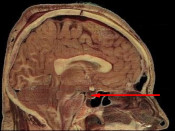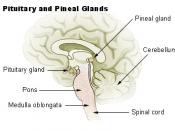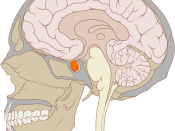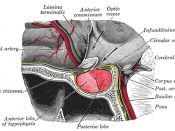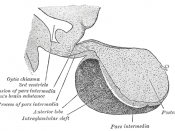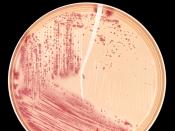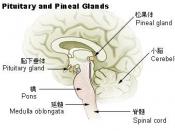PST In Pigs The biotechnology that I am using for this report is PST. PST (Porcine Somatotropin) aka growth hormone is a method of manipulating growth rate and enhancing lean meat production in pigs. So PST makes pigs bigger faster and also they produce leaner meat than normal untreated pigs. The word Porcine refers to pigs while Somatotropin means body growth and refers to the name of the hormone.
The way that this process in pigs is completed is that the protein called Porcine Somatotropin (PST) is injected into the pig to help the pig grow faster bigger and leaner. Porcine Somaotropin is a protein naturally made in the pig's pituitary glands. So by injecting more Porcine Somatotropin into the pigs body it gives the pig more of that protein so it helps the pig grow faster bigger and leaner. The way that Scientist gets extra Porcine Somatotropin is that they isolate the PST gene and then inserted into the bacteria called Escherichia coli.
Escherichia coli is found in the intestinal tract of human and animals. The bacteria produce large amounts of Porcine Somatoropin. Then the Porcine Somatotropin is purified and then injected into the pig. If Scientist didn't have the technology to produce Porcine Somatotropin then PST wouldn't be able to be used like it is today, because before they started producing Porcine Somatotropin it was very expensive to get and also pigs do not produce large amounts of this protein. Porcine Somatotropin can't be fed to pigs because then the protein becomes inactive (the protein becomes inactive during digestion) therefore Porcine Somatotropin must be injected so it stays active when entering the body.
Scientist first discovered porcine Somatotropin in the 1930s. Scientist found that growth in animals increased when they were injected with extracts from the pituitary gland. When the extracts were purified the growth hormone somatotropin was identified. The only source of Porcine Somatotropin was from the pituitary gland until recently, when they started producing Porcine Somatotropin using bacteria. In 1990 Iowa State University conducted a field trial using Porcine Somatotropin. This field trial showed farmers that the Porcine Somatotropin injected into pigs increased size and muscle and decreased fat tremendously in pigs.
There are very positive aspects by using Porcine Somatotropin in pigs. Porcine Somatotropin increases the size of pigs faster and also it cuts back on the pigs fat tremendously. It helps farmers make more money by being able to send pigs to the slaughterhouse quicker because Porcine Somatotropin gets the pigs to the size they need to be quicker so they can be slaughtered. Porcine Somatotropin works with female pigs and male pigs (castrated and non castrated) equally. Farmers can spend less money on feed, because the pigs can eat less and still grow larger faster. For all of the pork consumers it is a good thing because the meat that they eat is less fatty, lean, nutritious, and it still contains the great taste that pork has produced for years. It will help pork sell by getting people who try not to eat pork because it too fatty they will maybe then start to eat more pork because it is leaner and healthier to eat. Also there has been no sign of Porcine Somatotropin affecting the reproduction on pigs. Since Porcine Somatotropin is a protein it is neutralized during digestion, so that means when people eat pork the protein does not affect us in any type of way.
There are some disadvantages with using Porcine Somatotropin in pigs. Some of the larger pig farmers or producers that can afford Porcine Somatotropin can get the better prices on their pigs because their pigs are leaner, bigger, and more muscular. So while the bigger farmers make money off of PST pigs smaller farming industries that cant afford to use Porcine Somatotropin do not get the better and higher prices per pig that they might have been able to get before. So the smaller farming industries are getting less money because the larger farming industries with more money can afford Porcine Somatotropin. Some other disadvantages are that some people might be afraid to eat pork that has been genetically modified. Eventually after different generations of pigs have gone by their offspring could have some different results when they are injected with the growth hormone. One other disadvantage is that the price for leaner larger pigs will go down because there will be more pigs like that due to the wide use of Porcine Somatrotropin.
I feel that Porcine Somatotropin being injected into pigs to help them grow quicker, with more muscle, and less fat is a good thing. I think that it is a good process of what they do because Porcine Somatotropin naturally comes from the pig's pituary glands. The only difference is that scientist have put it into bacteria so they can produce more PST so farmers can purchase it at a lower price. Also this means that there will be more lean pork to buy. There is nothing better than a lean pork chop. Anyways those are my views on the use of Porcine Somatotropin in pigs.
References www.rationalskies.com/pigs/science/science.htm www.public.iastate.edu/~biotech_ed_info/BIOTECH-INFO/bio4.html www.reporcin.com www.agpub.on.ca
